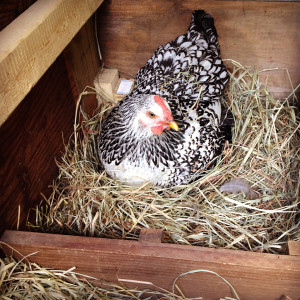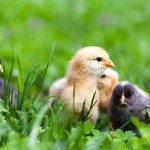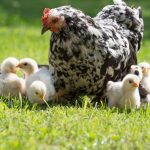I f raising a backyard flock was a treasure hunt, the ultimate prize would be a hen’s first egg. To extend this feeling of exhilaration and help hens produce wholesome, nutritious eggs long-term, care for the flock differently as they begin laying.
f raising a backyard flock was a treasure hunt, the ultimate prize would be a hen’s first egg. To extend this feeling of exhilaration and help hens produce wholesome, nutritious eggs long-term, care for the flock differently as they begin laying.
The transition from pullet to egg-laying hen often occurs at 4-5 months of age, subject to breed, environment and nutrition. Laying breed pullets will begin laying at about 18 to 20 weeks of age. A rooster is not necessary for egg production.
The first eggs a hen lays may be irregular – possibly small in size, with soft shells, no yolks or double yolks – but, after a week or so, egg production should become more consistent, with peak performance at about 30 weeks of age.
High-producing hens can lay up to 300 eggs per year; however, first year hens may lay fewer: about 200-250 eggs apiece. Because it takes approximately 25 hours for a hen to produce one egg, six eggs per week is an ideal goal.
To help hens reach this target – and stay happy and healthy, consider the following housing and nutrition tips.
Chicken Housing
After moving chicks from the brooder, introduce them directly to the coop that will become their forever home. This helps birds adjust to the coop well in advance of their first lay. Make sure the coop has comfortable nesting boxes that provide privacy to individual hens.
Once a hen begins laying, it’s her tendency to lay in the same spot moving forward. Create several comfortable, clean and cozy nesting areas to prevent hens from becoming competitive in the coop.
A general rule is to provide one 1-foot square nest box for every four or five hens because the flock will take turns using the boxes. Line each nest box with a thick layer of straw or other bedding to cushion the eggs and keep them clean and unbroken. Keep the nests up off the floor in the darkest corner of the coop.
Be sure all the nest areas have a uniform environment. If the hens decide one nest is preferable to the others, they may all try to use that nest, causing themselves stress, which can lead to egg breakage or egg eating. On our farm, we built the nests into the coops. Outdoor access to the nests allows us to collect eggs without disrupting the flock.
When pullets are nearing their first lay, their behavior changes. They may begin spending more time with the rooster, crouching for breeding or investigating the nesting area. At this time, keep hens in the coop for short periods of time. Place golf balls or decoy eggs in the nesting boxes to help the hens understand the use of the nesting boxes.
Chicken Nutrition
Once the first egg appears, the hen’s diet should also be adjusted.
Different nutrients are required to produce eggs as compared to what the pullet needs for growth. Young chicks and pullets need high protein levels as their body and feathers grow. At laying, switching to a complete feed with calcium and omega-3 fatty acids can help hens produce strong shells and nutritious eggs.
- Calcium: Calcium is essential to form strong egg shells. If the bird does not secure enough calcium from her feed, she may pull the nutrient from her bones, which could eventually lead to a weak skeletal structure. Since egg shells are developed at night, when birds are not eating, a consistent source of slow-release calcium in the diet is important. Oyster shells are the most common and reliable source of slow-release calcium. For strong shells and healthy hens, feed a complete layer feed with 16 percent protein and 3.25-4.5 percent calcium, like Purina® Layena® Premium Poultry Feed or Purina® Organic Layer Pellets or Crumbles. If your layer feed does not include Oyster Strong™ System, supplement the diet with free-choice oyster shells to add slow-release calcium.
- Omega-3: For even more nutritious eggs, offer laying hens a complete feed that includes flaxseed as a source of Omega-3. For example, when a diet of Purina® Layena® Plus Omega-3 was fed for at least three weeks, those hens produced large eggs (56 g) that contained 250 mg of Omega-3 per egg. 1 For comparison, a typical store-bought egg contains 50 mg of Omega-3 fatty acids per large egg (USDA: National Nutrient Base). Results may vary with factors such as total diet and hen health.



